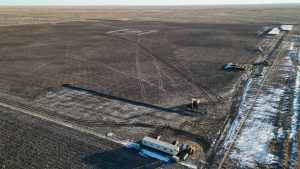Bamboo injected with an elastomeric polymer could prove to be a practical alternative to steel rebar as reinforcement in concrete.
That’s the conclusion of research done by three engineering technology students for a Capstone project at Lethbridge College in Alberta.
For their efforts which showed injected bamboo performed well against steel in low-load scenarios, the students received the Capstone Project of the Year Award for demonstrating ingenuity and sustainability from the Association of Science and Engineering Technology (ASET) Professionals of Alberta.
One of the advantages of the injected bamboo is that it is up to 20 per cent lighter than steel, the team’s research concluded, says Tyson Baldrey, who developed the product along with Randy Holmberg and Allan Johnston, at the time all students in the engineering design and drafting technology program at the college.
In practical applications, that could translate to less concrete required to build structures, says Baldrey, who has since graduated and gone on to work as a junior mechanical designer with Lethbridge-based ProjectWORX Engineering.
Another benefit is price. In a cost breakdown of 20-inch lengths of bamboo and its materials versus steel, the students concluded that bamboo was less expensive, he says.
A third benefit, and one that inspired the three students to do the project, is that bamboo is a sustainable material.
“You can grow it (quickly) almost anywhere. (Along) the whole lifecycle of steel, there are carbon footprints, whereas with bamboo it is minimal,” Baldrey points out. “We discovered that steel is always available on the global market, but at an inflated premium in regions where natural products exist that also have favourable structural characteristics.”
Baldrey says the team decided to use polyurethane as the injectable because it was readily available and would “closely mimic” the traits of natural forms of latex, tar, tree gums and rubber. It also acts as a repellant to water infiltrating the hollow of the bamboo.
He says applications will depend on the diameter size of the bamboo. “The size we had access to was comparable to that of number 10 or 10-millimetre steel rebar and showed potential in applications such as floor slabs or low-load building foundations.”
Baldrey sees potential for high-load applications with larger diameter bamboo.
“Further testing beyond what our equipment was capable of would be needed to evaluate” bamboo, he says.
Baldrey is optimistic that the research will spur others in the engineering world to take it to the next stage.
The bamboo capstone project was selected over about 20 other entrants from technical colleges in Alberta.
“We were certainly shocked at winning the award . . . taken aback,” says Baldrey.
Each team’s project was evaluated for “a pretty deep evidence of technical understanding,” says Barry Cavanaugh, CEO of ASET, noting that a committee of about seven engineering technologists comprised the panel of judges.
“The big things they (judges) are looking for is innovation and for it to clearly be practical,” he adds. “We saw a lot of those. I keep pinching myself and saying, ‘These are students coming up with these ideas and then they do the engineering design.’ These people are ready for the real world.”
Cavanaugh says the bamboo research project has caught the attention of the engineering community. “Virtually all the materials people and civil engineering people who I have heard from are pretty excited about it.”
He says last year’s winner developed and implemented a sustainable electrification program to replace a diesel generation system for Cape Verde, an island country in the central Atlantic Ocean.
The Capstone Awards were established in 2017 because of a growing interest among ASET members of capstone project efforts from students enrolled in engineering technology programs.











Recent Comments
comments for this post are closed